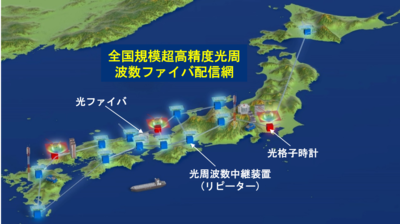Share this
Authors
Tomoya Akatsuka, Takashi Goh, Hiromitsu Imai, Katsuya Oguri, Atsushi Ishizawa, Ichiro Ushijima, Noriaki Ohmae, Masao Takamoto, Hidetoshi Katori, Toshikazu Hashimoto, Hideki Gotoh, and Tetsuomi Sogawa
Abstract
We report a cascaded optical fiber link which connects laboratories in RIKEN, the University of Tokyo, and NTT within a 100-km region using a transfer light at 1397 nm, a subharmonic of the Sr clock frequency. The multiple cascaded link employing several laser repeater stations benefits from a wide feedback bandwidth for fiber noise compensation, which allows constructing optical lattice clock networks based on the master-slave configuration. We developed the laser repeater stations based on planar lightwave circuits to significantly reduce the interferometer noise for improved link stability. We implemented a 240-km-long cascaded link in a UTokyo–NTT–UTokyo loop using light sent from RIKEN via a 30-km-long link. In environments with large fiber noise, the link instability is 3 × 10−16 at an averaging time of 1 s and reaches 1 × 10−18 at 2,600 s.
Optics Express:https://www.osapublishing.org/oe/abstract.cfm?uri=oe-28-7-9186
These Related Stories